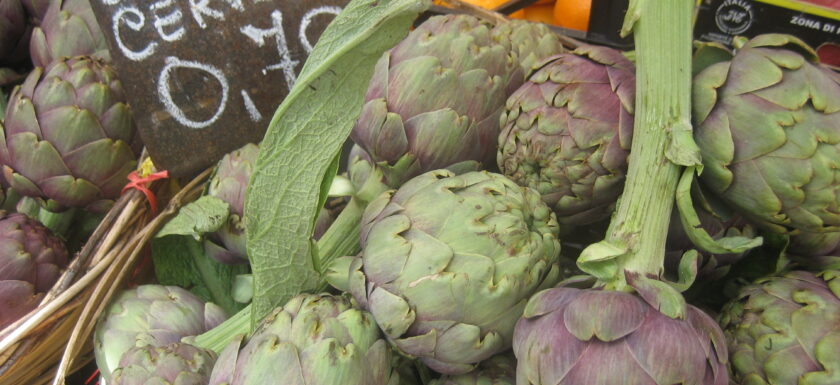Once spring is near, I start dreaming about Rome…and artichoke season.
Here’s an excerpt from “Hungry for Italy”:
“Order carciofi,” (pronounced car-CHO-fee), is what I tell travelers who ask for advice about Rome. Sure, you can run around oohing and aahing over the Forum, Colosseum, and Sistine Chapel, but for the True Roman Experience, you have to stop and taste the artichokes.

From late February to early May, overflowing crates of these green and purple-tinged beauties from surrounding farmlands begin to appear in the Eternal City. Signoras in smocks sit in the open air Campo dei Fiori market, peeling Carciofi Romaneschi with their tiny knives, as if they’re made of butter.
In season, every traditional restaurant has artichokes on their menus. They prepare them two ways: Alla Romana — stuffed with garlic and herbs, then slowly braised, to savory, tender perfection, or Alla Guidia, flattened and deep-fried, transformed to glistening deep gold flowers.

It’s the Alla Guidia I’m dreaming of when the plane lands, just in time for lunch. It’s a warm enough April day, a few suspicious clouds, but nothing dims the thrill of my first sight of umbrella pines, burnt orange stone buildings, broad Roman faces . . .

I drop my bags at my Trastevere apartment, rush across my favorite bridge — the Ponte Sisto — and head to the zona where all who seek the best Carciofi alla Giudia go: The Jewish Ghetto.
The Ghetto is one of Rome’s most enchanting areas — with a mix of such architectural stars as the crumbling Portico of Octavia from Imperial Roman days, to the Renaissance Turtle Fountain. Much of it is closed to cars, so it’s lovely to zig-zag through alleys under medieval archways, past tempting bakery windows.
This enchantment is in stark contrast to the ghetto’s bleak origins. It was created in 1555 by order of Pope Paul IV — a walled and gated seven-acre plot of low land, often flooded by the Tiber, the only place in Rome where Jews were permitted to live. Overcrowding caused them to build up, and today some of their six story buildings remain, shading narrow passageways. The ghetto existed for about 300 years, until Italy was unified in 1870.
During those dark centuries, despite poverty and oppression, a rich culture developed within the walls. That culture lives on in a special dialect (a mix of Latin, Italian, and Hebrew), and most strikingly, fantastic food, known as cucina ebraico. Since Kosher laws ruled that meat could not be combined with dairy, butter was eliminated and the practice of frying in oil became popular. And with all those artichokes growing nearby, Carciofi alla Guidia naturally became the Jewish Ghetto’s signature dish.
Once I hit the Ghetto’s restaurant stretch, the abundant joy of the season explodes: bouquets of artichokes in wicker baskets, tied with ribbons, adorn the eateries. I score a perfect table outside Da Gigetto, where an eight-foot tall artichoke tower graces the doorway.

A cameriere in white tuxedo jacket balances plates of golden Carciofi alla Giudia on his arm. When he sets one before me, I murmur alleluia to it, loving that first crisp, full flavored bite, raising my glass of prosecco to salute the moment. This is the taste that defines My Rome — earthy, nutty, and simply delicious.
“Buono?” says cameriere, sweeping my empty plate away.
I’m tempted to order ten more.
Could he be the same waiter who wowed me decades ago when I came here and had my first ever Carciofi alla Guidia?
In my pre-Roman days, artichokes were just thorny, off-putting, vegetables. They had played no part in my New Jersey kitchen childhood days. In fact, the first time I ever saw one was on TV, in a Little Rascals episode — the one where Stymie and Spanky are moseying around begging for food, and a kindly woman gives Stymie a box of dinner from her refrigerator, complete with artichoke.

He is baffled by the looks of the vegetable, but so starving he plops it in front of him and says, “I can tackle it,” then proceeds to open it, leaf by leaf. When he finally flattens the artichoke open, he gives it a quizzical look like only Stymie can, then tosses it away, with the unforgettable line: “It might choke Artie, but it ain’t gonna choke Stymie!”
So I blame Stymie for turning me off to artichokes.
That is, until I discovered the alla Giudia way. Thanks to advice from San Francisco foodie friends, Da Gigetto was on the restaurant list for the first trip I took to Rome with my husband. We took our places and did what we often did during those early days of visiting Italy: pointed to what someone else was eating that looked good and said, “We’ll have that.” That, (Carciofi alla Giudia), turned out to become the signature dish for our trip, ordered nightly, gobbled up with glee.
The Little Rascals faded away as Rome’s sexy take on the vegetable took over. Romans associate artichokes with Greek mythology — a legend where Zeus lusts after a young maiden, Cynara, who was so beautiful he declared her a Goddess. When Cynara turned down his advances, Zeus thought up a clever revenge to make her unapproachable to any other man: “Make this beauty . . . an artichoke!”
In Imperial days, artichokes were served at Roman orgies, praised by such wise men as Pliny the Elder, who wrote of their healing properties — the thistle that stimulates the bile, cleans the liver, and best of all: serves as a powerful aphrodisiac.
Only men were supposed to enjoy these libido-enhancing vegetables (God forbid women enjoy sex!) until along came Catherine de Medici, in the Renaissance, who took artichokes with her to France when she married Henry III. It caused much the scandal, with Catherine caring not at a bit, letting all gasp around her as she artichoke-gorged.
Then there’s me, spending April in Rome, riding the final springtime wave of artichoke season with my friends. I timed the whole trip around a climactic event: the Sagra del Carciofo (Artichoke Festival), in Sezze, a medieval village about an hour south of Rome.

My friend Joanie, an ex-New Yorker turned Roman, loves the idea of a Sunday drive. So we’re off in her Panda, on the route that was once the Appian Way.

As we get to the old village, tucked into the hillside, we hear jazz. In a courtyard we discover a handsome ensemble — clarinet, sax, trombone — blasting out a swoon-inducing “Taste of Honey.” Then it’s up the narrow, winding cobblestoned via, surrounded by baskets of artichokes on balconies and storefronts.

Locals casually parade by in Renaissance costumes: men in tights and tunics, signoras in long traditional skirts, holding artichoke bouquets, swirling to drumbeats and tambourines. Bambini dart about — sassy girls dressed like their mammas, thrilled to be posing for pictures.

The sharp, woodsy aroma of frying, roasting, grilling artichokes fills the air. Joanie carefully picks our lunch spot: a fruttivendolo (fruit store) where plastic tables and chairs are set up outside for the occasion. In the kitchen signoras stir over steaming pasta pots, while their daughters in tight t-shirts and jeans bob and weave among us, serving overflowing plates of course after carciofi course — bread salad with artichokes, bow-tie pasta with artichokes, sausage and fried artichokes, artichoke liqueur…
Sated, we head back to the hilltop piazza, where a raven-haired signora, dressed in a traditional peasant wide black skirt, bursts into a spontaneous tarantella. She’s writhing, chest arched to the heavens, breasts heaving with passion, serenaded by an impossibly handsome mandolin player.

She’s the Goddess Cynara, come alive.
We join a circle that forms around them, all of us holding artichokes. Cynara throws her head back to the heavens, her eyes lock with the mandolin player. We gasp, caught up in the thunderbolt of passion. And I marvel that Italians can even turn an Artichoke Festival into a sexy experience — celebrating spring, delicious pleasures, and as always, Amore.
***
This story is an excerpt from “Hungry for Italy: Culinary Adventures in the Bel Paese”.




